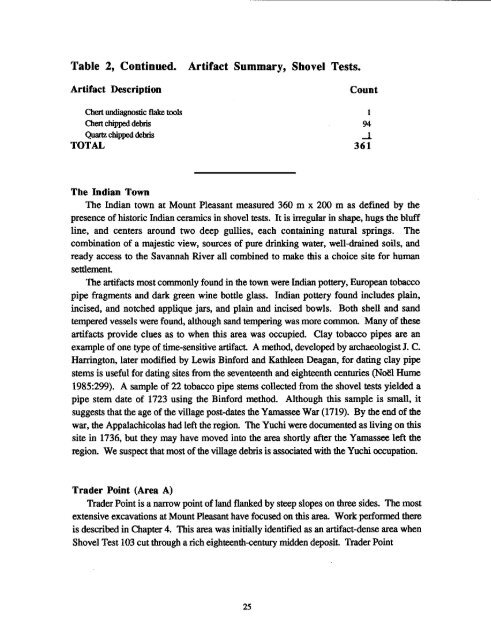Ye Pleasant Mount: 1989 1990 Excavations - Open site which ...
Ye Pleasant Mount: 1989 1990 Excavations - Open site which ...
Ye Pleasant Mount: 1989 1990 Excavations - Open site which ...
You also want an ePaper? Increase the reach of your titles
YUMPU automatically turns print PDFs into web optimized ePapers that Google loves.
Table 2, Continued. Artifact Summary, Shovel Tests.<br />
Artifact Description Count<br />
Chert undiagnostic flake tools I<br />
Chert chipped debris 94<br />
Quartz chipped debris -l<br />
TOTAL 361<br />
The Indian Town<br />
The Indian town at <strong>Mount</strong> <strong>Pleasant</strong> measured 360 m x 200 m as defined by the<br />
presence ofhistoric Indian ceramics in shovel tests. It is irregular in shape, hugs the bluff<br />
line, and centers around two deep gullies, each containing natural springs. The<br />
combination of a majestic view, sources of pure drinking water, well-drained soils, and<br />
ready access to the Savannah River all combined to make this a choice <strong>site</strong> for human<br />
settlement<br />
The artifacts most commonly found in the town were Indian pottery, European tobacco<br />
pipe fragments and dark green wine bottle glass. Indian pottery found includes plain,<br />
incised, and notched applique jars, and plain and incised bowls. Both shell and sand<br />
tempered vessels were found, although sand tempering was more common. Many ofthese<br />
artifacts provide clues as to when this area was occupied. Clay tobacco pipes are an<br />
example of one type of time-sensitive artifact A method, developed by archaeologist J. C.<br />
Harrington, later modified by Lewis Binford and Kathleen Deagan, for dating clay pipe<br />
stems is useful for dating <strong>site</strong>s from the seventeenth and eighteenth centuries (Noel Hume<br />
1985:299). A sample of 22 tobacco pipe sterns collected from the shovel tests yielded a<br />
pipe stem date of 1723 using the Binford method. Although this sample is small, it<br />
suggests that the age of the village post-dates the Yarnassee War (1719). By the end of the<br />
war, the Appalachicolas had left the region. The Yuchi were documented as living on this<br />
<strong>site</strong> in 1736, but they may have moved into the area shortly after the Yamassee left the<br />
region. We suspect that most ofthe village debris is associated with the Yuchi occupation.<br />
Trader Point (Area A)<br />
Trader Point is a narrow point ofland flanked by steep slopes on three sides. The most<br />
extensive excavations at <strong>Mount</strong> <strong>Pleasant</strong> have focused on this area. Work performed there<br />
is described in Chapter 4. This area was initially identified as an artifact-dense area when<br />
Shovel Test 103 cut through a rich eighteenth-eentury midden deposit. Trader Point<br />
25










